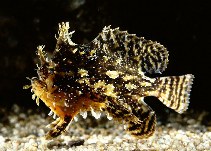| Family: |
Antennariidae (Frogfishes) |
| Max. size: |
20 cm TL (male/unsexed) |
| Environment: |
reef-associated; marine; depth range 0 - 50 m, oceanodromous |
| Distribution: |
Western Atlantic: Rio de la Plata estuary, Uruguay, to Canada (Ref. 5951). Eastern Atlantic: Azores and off West Africa; Gulf Stream drift stray in Norway (Ref. 28571). Indian Ocean: South Africa to Red Sea, Madagascar, Réunion and Mauritius, eastward to India and Sri Lanka. Western Pacific: Hokkaido to tropical Australia (as far south as Perth in the west and Sydney in the east), Taiwan, Philippines, Moluccas, southern Papua New Guinea, Guam, Tonga, New Caledonia and New Zealand; Mariana Islands in Micronesia (Ref. 1602). Occurrence in the eastern Pacific remains to be verifed and confirmed. |
| Diagnosis: |
Dorsal spines (total): 3-3; Dorsal soft rays (total): 11-13; Anal spines: 0-0; Anal soft rays: 6-13. Diagnosis: body short and globose; mouth large with many small, villiform teeth; skin naked, but head, body and fins covered with numerous skin flaps; very long pelvic fins (> 25% SL); unprotected illicium or lure attains less than half of second dorsal-fin spine and 4.5-9.3% of SL (Ref. 57225).
Description: characterized by having large pelvic fins; unbranched pelvic rays (Ref. 90102). Illicium much shorter than 2nd dorsal spine; esca globular with short filaments; pectoral stalk free from body for most of its length (Ref. 26938). Illicium and second dorsal-fin spine close-set, former apparently emerging from base of latter; second dorsal-fin spine narrow and slightly curved backwards, not attached to head by membrane and attaining 13.3-19.3% of standard length. Third dorsal-fin spine narrow and slightly curved backwards, attached to the head by a membrane and attaining 19.3-29.3% of SL: eye diameter 5.0-8.7% of SL (Ref. 57225). Relatively smooth skin without obvious spinules; head, body, fins and dorsal spines usually have scattered cirri and slender skin flaps (Ref. 90102).
Coloration: color variable, from more or less uniform grey to pattern of stripes and spots varying from brown to yellow; body sometimes covered with numerous small, black dots or fine white lines; pectorals nad pelvics occasionally orange-edged; skin filaments white; illicium without bands; color mottled green with numerous fleshy weed-like dermal appendages (Ref. 1602) blending with the floating Sargassum weed in which it is usually found. |
| Biology: |
Found near the surface, usually associated with floating objects (Ref. 26340) or Sargassum. Found near shore and occasionally among floating seaweeds (Ref. 57225). Commonly blown into shore and bay waters during storms (Ref. 7251). Epipelagic (Ref. 58302). A solitary (Ref. 26340) and voracious predator (Ref. 5521). They feed on fishes and shrimps that seek refuge in the floating weeds (Ref. 48635). Oviparous. Eggs are bound in ribbon-like sheath or mass of gelatinous mucus called 'egg raft' or 'veil' (Ref. 6773, 48635). Solitary or loose groups among floating seaweed (Ref 90102). |
| IUCN Red List Status: |
Least Concern (LC); Date assessed: 09 May 2013 Ref. (130435)
|
| Threat to humans: |
reports of ciguatera poisoning |
Source and more info: www.fishbase.org. For personal, classroom, and other internal use only. Not for publication.
